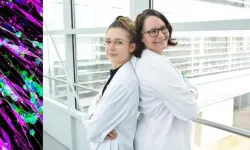Controlled by light alone, new smart materials twist, bend and move
Technology paves way for intelligent solar cells, other highly efficient devices programmed at the macro and nano scale
2021-03-12
(Press-News.org) Researchers at Tufts University School of Engineering have created light-activated composite devices able to execute precise, visible movements and form complex three-dimensional shapes without the need for wires or other actuating materials or energy sources. The design combines programmable photonic crystals with an elastomeric composite that can be engineered at the macro and nano scale to respond to illumination.
The research provides new avenues for the development of smart light-driven systems such as high-efficiency, self-aligning solar cells that automatically follow the sun's direction and angle of light, light-actuated microfluidic valves or soft robots that move with light on demand. A "photonic sunflower," whose petals curl towards and away from illumination and which tracks the path and angle of the light, demonstrates the technology in a paper that appears March 12th, 2021 in Nature Communications.
Color results from the absorption and reflection of light. Behind every flash of an iridescent butterfly wing or opal gemstone lie complex interactions in which natural photonic crystals embedded in the wing or stone absorb light of specific frequencies and reflect others. The angle at which the light meets the crystalline surface can affect which wavelengths are absorbed and the heat that is generated from that absorbed energy.
The photonic material designed by the Tufts team joins two layers: an opal-like film made of silk fibroin doped with gold nanoparticles (AuNPs), forming photonic crystals, and an underlying substrate of polydimethylsiloxane (PDMS), a silicon-based polymer. In addition to remarkable flexibility, durability, and optical properties, silk fibroin is unusual in having a negative coefficient of thermal expansion (CTE), meaning that it contracts when heated and expands when cooled. PDMS, in contrast, has a high CTE and expands rapidly when heated. As a result, when the novel material is exposed to light, one layer heats up much more rapidly than the other, so the material bends as one side expands and the other contracts or expands more slowly.
"With our approach, we can pattern these opal-like films at multiple scales to design the way they absorb and reflect light. When the light moves and the quantity of energy that's absorbed changes, the material folds and moves differently as a function of its relative position to that light," said Fiorenzo Omenetto, corresponding author of the study and the Frank C. Doble Professor of Engineering at Tufts.
Whereas most optomechanical devices that convert light to movement involve complex and energy-intensive fabrication or setups, "We are able to achieve exquisite control of light-energy conversion and generate 'macro motion' of these materials without the need for any electricity or wires," Omenetto said.
The researchers programmed the photonic crystal films by applying stencils and then exposing them to water vapor to generate specific patterns. The pattern of surface water altered the wavelength of absorbed and reflected light from the film, thus causing the material to bend, fold and twist in different ways, depending on the geometry of the pattern, when exposed to laser light.
The authors demonstrated in their study a "photonic sunflower," with integrated solar cells in the bilayer film so that the cells tracked the light source. The photonic sunflower kept the angle between the solar cells and the laser beam nearly constant, maximizing the cells' efficiency as the light moved. The system would work as well with white light as it does with laser light. Such wireless, light-responsive, heliotropic (sun-following) systems could potentially enhance light-to-energy conversion efficiency for the solar power industry. The team's demonstrations of the material also included a butterfly whose wings opened and closed in response to light and a self-folding box.
INFORMATION:
The research extends ongoing studies by Omenetto and colleagues at Tufts School of Engineering on the use of silk as an advanced material platform in photonics, electronics, and nanotechnology.
ELSE PRESS RELEASES FROM THIS DATE:
2021-03-12
A new study led by University of Maryland and UCLA researchers found that DNA from tissue samples can be used to accurately predict the age of bats in the wild. The study also showed age-related changes to the DNA of long-lived species are different from those in short-lived species, especially in regions of the genome near genes associated with cancer and immunity. This work provides new insight into causes of age-related declines.
This is the first research paper to show that animals in the wild can be accurately aged using an epigenetic clock, which predicts age based on specific changes to DNA. This work ...
2021-03-12
Osaka, Japan - Scientists from the Institute of Scientific and Industrial Research at Osaka University fabricated nanopores in silicon dioxide, that were only 300 nm, in diameter surrounded by electrodes. These nanopores could prevent particles from entering just by applying a voltage, which may permit the development of sensors that can detect very small concentrations of target molecules, as well as next-generation DNA sequencing technology.
Nanopores are tiny holes that are wide enough for just a single molecule or particle to pass through. The motion of nanoparticles through these holes ...
2021-03-12
Researchers at UCL have solved a major piece of the puzzle that makes up the ancient Greek astronomical calculator known as the Antikythera Mechanism, a hand-powered mechanical device that was used to predict astronomical events.
Known to many as the world's first analogue computer, the Antikythera Mechanism is the most complex piece of engineering to have survived from the ancient world. The 2,000-year-old device was used to predict the positions of the Sun, Moon and the planets as well as lunar and solar eclipses.
Published in Scientific Reports, the paper from the multidisciplinary UCL Antikythera Research Team reveals a new display ...
2021-03-12
PHILADELPHIA -- (March 12, 2021) -- Scientists at The Wistar Institute identified a new function of ADAR1, a protein responsible for RNA editing, discovering that the ADAR1p110 isoform regulates genome stability at chromosome ends and is required for continued proliferation of cancer cells. These findings, reported in Nature Communications, reveal an additional oncogenic function of ADAR1 and reaffirm its potential as a therapeutic target in cancer.
The lab of Kazuko Nishikura, Ph.D., professor in the Gene Expression & Regulation Program of The Wistar Institute Cancer Center, was one of the first to discover ADAR1 in mammalian cells and to characterize the process of RNA editing ...
2021-03-12
A factor that turns malignant tumors into benign ones? - That is exactly what scientists at St. Anna Children's Cancer Research Institute have discovered. Together with colleagues from the Medical University of Vienna and the University of Vienna (Faculty of Chemistry), they studied tumors of the peripheral nervous system in children, namely neuroblastomas. The scientists discovered that the uncontrolled growth of benign neuroblastomas is stopped by a signal molecule produced by Schwann cells present within these tumors. This natural "brake" also works on malignant neuroblastoma ...
2021-03-12
Brominated flame retardants (BFRs) are found in furniture, electronics, and kitchenware to slow the spread of flames in the event of a fire. However, it has been shown that these molecules may lead to early mammary gland development, which is linked to an increased risk of breast cancer. The study on the subject by Professor Isabelle Plante from the Institut national de la recherche scientifique (INRS) made the cover of the February issue of the journal Toxicological Sciences.
Part of the flame retardants are considered to be endocrine disruptors, i.e. they interfere with the hormonal system. Since they are not directly bound to the material in which they are added, the molecules escape easily. They are then found in house ...
2021-03-12
Chest pain is misdiagnosed in women more frequently than in men, according to research presented today at ESC Acute CardioVascular Care 2021, an online scientific congress of the European Society of Cardiology (ESC).1 The study also found that women with chest pain were more likely than men to wait over 12 hours before seeking medical help.
"Our findings suggest a gender gap in the first evaluation of chest pain, with the likelihood of heart attack being underestimated in women," said study author Dr. Gemma Martinez-Nadal of the Hospital Clinic of Barcelona, Spain. "The low suspicion of heart attack occurs in both women themselves and in physicians, leading to higher risks of late diagnosis and misdiagnosis."
This study examined gender differences in the presentation, ...
2021-03-11
As gatherings to observe whooping cranes join the ranks of online-only events this year, a new study offers insight into how the endangered bird is faring on a landscape increasingly dotted with wind turbines. The paper, published this week in Ecological Applications, reports that whooping cranes migrating through the U.S. Great Plains avoid "rest stop" sites that are within 5 km of wind-energy infrastructure.
Avoidance of wind turbines can decrease collision mortality for birds, but can also make it more difficult and time-consuming for migrating flocks to find safe and suitable rest and refueling locations. The study's insights into migratory behavior ...
2021-03-11
COLUMBUS, Ohio - Overweight low-income mothers of young kids ate fewer fast-food meals and high-fat snacks after participating in a study - not because researchers told them what not to eat, but because the lifestyle intervention being evaluated helped lower the moms' stress, research suggests.
The 16-week program was aimed at preventing weight gain by promoting stress management, healthy eating and physical activity. The methods to get there were simple steps tucked into lessons on time management and prioritizing, many demonstrated in a series ...
2021-03-11
In the field of robotics, metals offer advantages like strength, durability, and electrical conductivity. But, they are heavy and rigid--properties that are undesirable in soft and flexible systems for wearable computing and human-machine interfaces.
Hydrogels, on the other hand, are lightweight, stretchable, and biocompatible, making them excellent materials for contact lenses and tissue engineering scaffolding. They are, however, poor at conducting electricity, which is needed for digital circuits and bioelectronics applications.
Researchers in Carnegie Mellon University's Soft Machines Lab have developed a unique silver-hydrogel composite that has high electrical ...
LAST 30 PRESS RELEASES:
[Press-News.org] Controlled by light alone, new smart materials twist, bend and move
Technology paves way for intelligent solar cells, other highly efficient devices programmed at the macro and nano scale






